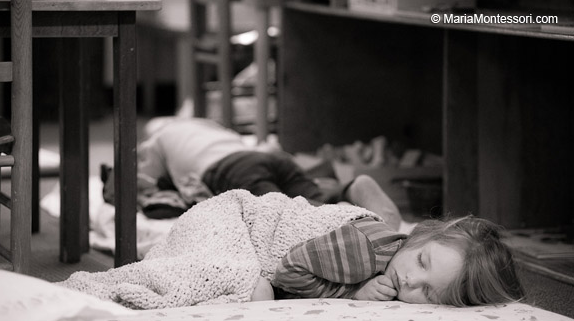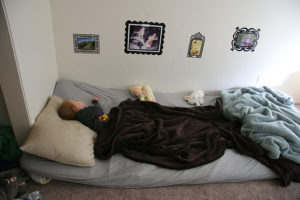
October 25, 2022
or The Bed Less Slept In
I’m a Montessori teacher. My trainer used to say that by the end of the training, we’d have Montessori in our blood; in my case, I think she was right. I truly love the philosophy and try to apply it not just to the children in my classroom, but this past year with my infant daughter, Em. (i) Which is why it pains me to admit that I have had a difficult relationship with my daughter’s floor bed.
My daughter was born into a tumultuous year in our lives. When she was three months old, we moved cross-country. When she was six months old, we moved again. She’ll be ten months in a month; we’ll be moving then, too. Needless to say, it’s been a challenge for her to have the perfect Montessori environment in which to grow. In fact, she was almost seven months old before we were able to transition her to her floor bed (due to safety issues). This is not ideal, and I realize that; however, life just got in the way (as it has a habit of doing).
From the day she was born, Em was a reluctant sleeper. VERY reluctant. Naps were inevitably prefaced by loud protests, and I tended to think of them with all the trepidation of approaching battles—one where the outcome was not at all certain. When we got her floor bed, I was nervous. VERY nervous. She already hates to sleep, and now I’m giving her easy access out of the dreaded bed? Gulp! But we jumped in, thoroughly baby-proofed her bedroom, bought the mattress and put the pack’ n’ play away.
That first night, I realized all my fears had been completely founded. She rolled off the bed several times, waking herself up and causing a hysterical scene every time we tried to get her back to sleep. Days after, she realized that although she couldn’t yet crawl, she could scoot herself off the offending mattress. I’d go in and place her back on the mattress what felt like a million times in ten minutes. (She’d scoot off as soon as I’d gone through the gate in her room, voicing her displeasure at the top of her lungs). I tried laying with her on the bed; that was a short-lived phase, as I’d just end up getting my hair pulled, arms pinched, and an even more over-excited baby who refused to sleep.
One night, exhausted, Em screaming from the next room, hands holding onto the bars of the gate at the door like a clichéd jailbird (all she needed was the tin can banging against the bars), my husband and I seriously considered bringing back her pack’ n’ play. (I’m not sure exactly what we thought this would solve, since she was a reluctant sleeper, even with the pack’ n’ play. I can only claim to have been under the 4 am spell that turns irrationality into lucidity. We were just plain desperate.) However, as dawn crept in through the blinds of that fateful morning, and silence finally reigned, I had one thought before I drifted off to sleep. No one said it was going to be easy.
For some odd reason, this thought gave me peace. And conviction. Armed with these new tools, I approached sleep with a newfound calm. I decided on a routine that I would stick to, no matter what, and stopped trying to guess my daughter’s magic formula for peaceful sleep. She’d still scoot off the bed immediately—you could count on it!—but armed with my new unruffled confidence, I’d simply scoop her back up, place her back on the bed, pat her bottom, say good night, and step out of the room. Each time. Every single time she’d scoot off the bed until she’d finally go to sleep.
There sometimes seems to be a sense when talking about Montessori that the model classroom simply appears, like magic. That children somehow shed their deviations the moment they step over the threshold of a Montessori classroom. This has not been the case for me, not in the classroom and not in my home. Montessori theory and articles are full of triumphs and successes—and so they should be because Montessori really works! However, I think the emphasis on the happily-ever-after sometimes takes the focus away from the fact that the path to this utopia is hard. In my first year of teaching, I’d fall asleep in movie theaters because I couldn’t stay awake past 8 pm, I was so exhausted. In my classroom, there’d be children whose family lives were so at odds with Montessori, that following limits or working independently seemed like a foreign language to them. (One that they could certainly learn, and for the most part did, but not easily and assuredly not perfectly.) We’re not perfect adults, there are no perfect children, and the perfect life has continuously eluded me. The first years of teaching are hard. The first months of school are hard. However, walk into a Montessori classroom in the spring. Ah! There it is! This is what all the articles are talking about. Here is concentration, community, and independence. It is the end result that makes the difficult months worthwhile.

Somewhere along the line, I’d forgotten that the path is hard. I’d been under some illusion that “if you put her in a floor bed, sleep will come,” and had been terribly disappointed that this was not the case. Although the floor bed has many advantages (spatial learning as to where the edge of the bed is, independence, cost, and more!), the one that has been forefront for us is the development of the will. It has also been an exercise for me in setting appropriate limits, and being authoritative, not authoritarian. I know she wants to stay with me and play, but she needs to take a nap. However, I cannot force her to fall asleep—all I can do is create the environment for sleep, and then she has to choose to do that on her own. And the floor bed allows her the power to do it when she’s ready.
In Education for a New World, Montessori writes that “Whereas the breaking of the will is instantaneous, the development of it is a lengthy process, because it is growth, and depends on aid from the environment” (88). As the child develops the will, through continuous practice in the environment, the ability to obey emerges. Not forced from the outside, but willingly, from within.
After weeks of my consistent routine, confidently and calmly enforced, I finally began to see the light at the end of the tunnel. Suddenly, she’d only scoot off the bed, two, maybe three times, before falling asleep. And she’d still cry, but the panicked rage seemed to have gone missing. Sometimes, on that third time, she’d still be awake on the bed, but playing with her owl pillow, or calmly gazing at the shadows on the wall, cooing, until she drifted off to sleep. Despite my conviction, I was still surprised, and amazed. It’s working… maybe… I hope!
Weeks later still, as I am sitting here writing this, I am happy to report that I just placed Em down for a nap, and she went peacefully to sleep, with nary a peep—and that this is now (mostly) normal in our house. Sometimes I still get the timing wrong, where I think she’s sleepy and put her down, but it turns out she was not quite ready to sleep yet. When this happens, she usually goes over to her shelf and chooses a toy to play with or a book to flip through. After a little while, she’ll come over to the gate and make a couple of calm “Yaaaaa….” sounds; my cue to go back in and place her back on the bed. I put her back in, kiss her goodnight, and every single time that this has happened, when she has called me from the gate, and I go to place her back on the bed, she falls asleep peacefully and in minutes. How empowering that a nine-month-old can choose when she wants to nap!
And, best of all, when she wakes up, she will most likely stay on the bed for a little while, playing with the owl pillow. Then, she’ll scoot off, and go visit her shelves, maybe knock over her stacking toys or play with her rattle. After a little while, she’ll come over to the gate, and make a noise, asking me to come and get her. And she’ll greet me with a smile on her face.
(i) Not her real name.